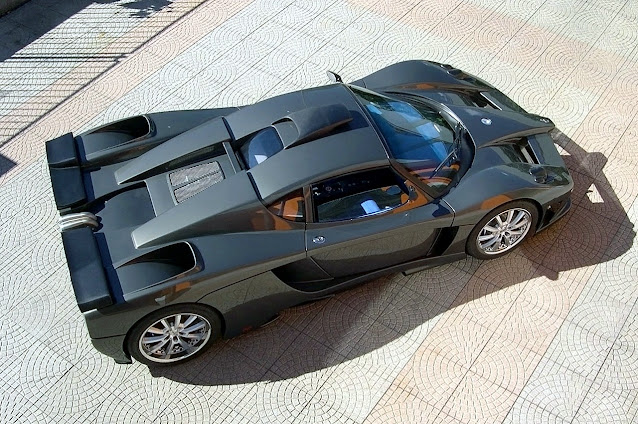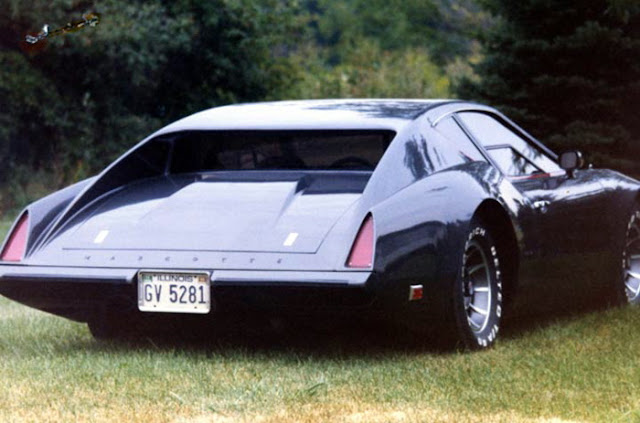The Simbol Design Lavazza GTX story
 |
| Simbol Levazza GTX, from above |
 |
| Lavazza designed K1 Attack |
Their most recent products are the Lavazza GTX and its stablemate the GTX-R roadster. Both feature styling that merges themes from their contemporaries, like the Pagani Zonda and the Ferrari Enzo, but also echo cues from Lavazza's Minotaur designed by John Forakis. Aerodynamics play a big part in dictating the the shape. Deep channels in the hood let air pass through the nose of the car for downforce, large air intakes at its haunches feed cool air to the engine bay, and a large diffuser and wing surfaces round out the tail. The whole package looks quite potent, if a bit derivative.
 |
| Simbol Levazza GTX-R, from above |
Power comes from a BMW-sourced 5.4-liter V12 producing 489HP that can accelerate the GTX-R from 0 to 100 km/h (0 to 62 mph) in just 4.3 seconds. The entire vehicle tips the scales at just 2380 pounds, which means in its most powerful guise the Lavazza GTX-R delivers a weight-to-power ratio of just 3.8 pounds per horsepower and a 220mph top speed.
Under the Lavazza GTX-R’s carbon fiber and Kevlar shell sits a conventional steel-tube chassis with the V-12 engine mid-mounted. Drive is sent to the rear wheels via a six-speed electro-pneumatic gearbox with controls mounted on the steering wheel. The GTX/R chassis is designed to support up to 1000 hp.
The GTX has been in development and prototype testing since 2004. The car was slated be available in the spring of 2009 in limited production, in order to ensure exclusivity and a secure investment for the buyers. They planned to offer different engines and fittings per costumer specification, as well as rolling chassis in countries where the car was not approved. However, no production figures have been found thus far in the course of researching this piece.
Many would-be supercar purveyors make a big splash and then vanish into thin air, sometimes resurfacing in a new guise.
It will be interesting to learn what has become of Simbol. Their website is currently not functional. It wouldn't surprise me to see the GTX present itself in a new form in the near future.
Time will tell...
Specifications
Body: Carbon Kevlar
Length: 419 cm
Width: 190 cm front / 198 cm
Height: 98 cm Roadster / 104 cm coupe
Wheelbase cm.: 263
Weight: 1080 kg
Wheels: Front 245/40 R18 Rear 345/30 R19
Tire: Michelin Pilot Sport ZP Run Flat
Chassis: Tubular steel section joint special
Transmission: 6 speed electro-pneumatic
Max Speed: 220 mph
0-60 mph: 4.6 sec.
Engine: V12 620 HP
Length: 419 cm
Width: 190 cm front / 198 cm
Height: 98 cm Roadster / 104 cm coupe
Wheelbase cm.: 263
Weight: 1080 kg
Wheels: Front 245/40 R18 Rear 345/30 R19
Tire: Michelin Pilot Sport ZP Run Flat
Chassis: Tubular steel section joint special
Transmission: 6 speed electro-pneumatic
Max Speed: 220 mph
0-60 mph: 4.6 sec.
Engine: V12 620 HP
Sources:
seriouswheels.com
autoblog.com
seriouswheels.com
autoblog.com
Gatsbyonline.com
 |
| Simbol Levazza GTX |
 |
| Simbol Levazza GTX, from behind |
 |
| Simbol Levazza GTX |
 |
| Simbol Levazza GTX, ready for take-off! |
 |
| Simbol Levazza GTX, from the rear |
 |
| Simbol Levazza GTX |
 |
| Simbol Levazza GTX, from above |
 |
| Simbol Levazza GTX |
 |
| Simbol Levazza GTX |
 |
| Simbol Levazza GTX, from above |
 |
| Simbol Levazza GTX-R |
 |
| Simbol Levazza GTX & GTX-R |
 |
| Simbol Levazza GTX-R Roadster |
 |
| Simbol Levazza GTX & GTX-R |
 |
| Simbol Levazza GTX, chassi |








Comments
Post a Comment